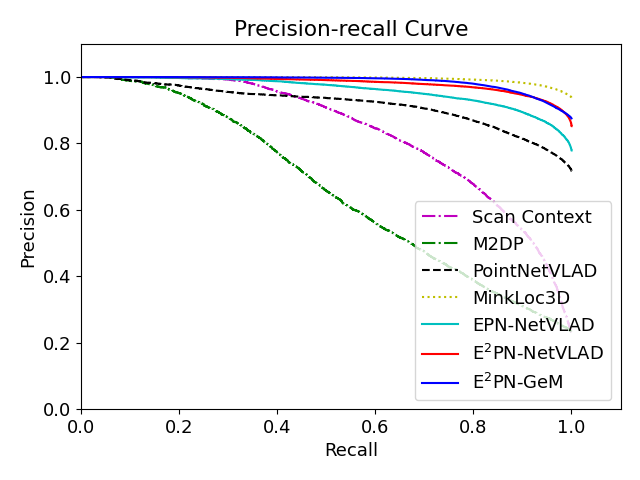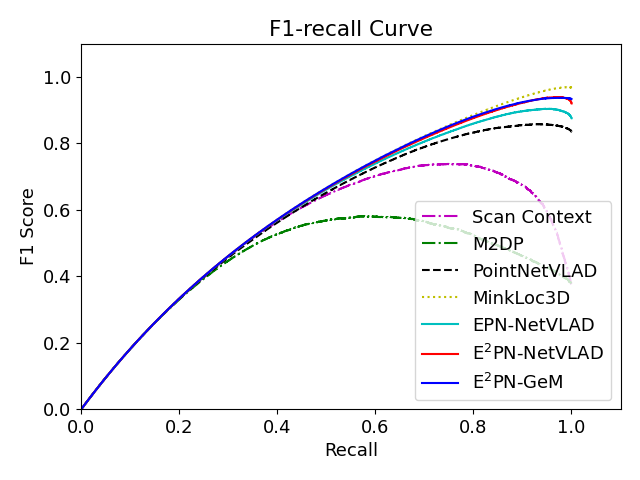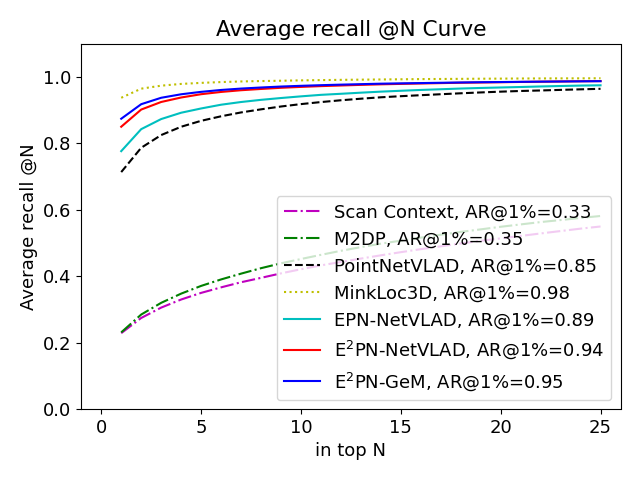This repository contains the code for SE(3)-Equivariant Point Cloud-based Place Recognition.
@inproceedings{lin2022seequivariant,
title={{SE}(3)-Equivariant Point Cloud-Based Place Recognition},
author={Chien Erh Lin and Jingwei Song and Ray Zhang and Minghan Zhu and Maani Ghaffari},
booktitle={6th Annual Conference on Robot Learning},
year={2022},
url={https://openreview.net/forum?id=gUtbYFHluAg}
}
This paper reports on a new 3D point cloud-based place recognition framework that uses SE(3)-equivariant networks to learn SE(3)-invariant global descriptors. We discover that, unlike existing methods, learned SE(3)-invariant global descriptors are more robust to matching inaccuracy and failure in severe rotation and translation configurations. Mobile robots undergo arbitrary rotational and translational movements. The SE(3)-invariant property ensures the learned descriptors are robust to the rotation and translation changes in the robot pose and can represent the intrinsic geometric information of the scene. Furthermore, we have discovered that the attention module aids in the enhancement of performance while allowing significant downsampling. We evaluate the performance of the proposed framework on real-world data sets. The experimental results show that the proposed framework outperforms state-of-the-art baselines in various metrics, leading to a reliable point cloud-based place recognition network.

In the paper, we tested both EPN and E2PN as encoder for learning equivariant features from point clouds. The modules for two encoders are slightly different. To avoid conficts, we separte them into two branches. The master branch contains code for testing EPN, and the e2pn brach contains code for testing E2PN.
For EPN:
git checkout master
For E2PN:
git checkout e2pn
The code has been tested on a Ubuntu 20.04 machine equipped with Intel i9-10900K CPU with a 3.7 GHz processor and an Nvidia GeForce RTX 3090. The code has been tested with python 3.8.12 and pytorch 1.11.0. See docker folder for how to use docker image and build docker container. If you are insterested in building the environment, the dependencies are listed in the DockerFile. In addition to docker, The module and additional dependencies can be installed with
cd vgtk
python setup.py install
Note: It might require root access to install the module.
This repository is tested with Oxford Robocar benchmark created by PointNetVLAD, and can be downloaded here.
We create training tuples following PointNetVLAD's procedure to generate training and testing tuples in pickle files. The picke files we used for training and testing can be downloaded here. Please see PointNetVLAD's generating_queries folder for detail implementation.
Pretrained weights for epn_netvlad, epn_gem, atten_epn_netvlad, e2pn_netvlad, and e2pn_gem models can be downloaded here.
First, change the cofigurations for training settings in config.py file. Especially for variables such as: DATASET_FOLDER, MODEL, TRAIN_FILE, and TEST_FILE
After changing the cofigurations, the following command can be used to train the model:
python train_oxford.py
First, change the cofigurations for training settings in config.py file. Especially for variables such as: EVAL_MODEL, RESUME_FILENAME, EVAL_DATABASE_FILE, and EVAL_QUERY_FILE.
After changing the cofigurations, the following command can be used for the evaluation:
For evaluation on Oxford:
python eval_oxford.py
For evaluation on KITTI:
python eval_kitti.py
Baseline results from PointNetVLAD, MinkLoc3D, Scan Context, and M2DP can be downloaded here.
Results show the precision-recall curve, f1-recall curve, and average recall at top N curve.



- EPN-PointCloud: Equivariant Point Network (EPN). We modified it to be our SE(3)-invariant point cloud local feature extractor in our framework.
- E2PN: Efficient SE(3)-Equivariant Point Network. We modified it to be our SE(3)-invariant point cloud local feature extractor in our framework.
- PointNetVLAD in Tensorflow and PointNetVlad-Pytorch. We utilized the benchmark_dataset, code for training with quadruplet loss, and place recognition evaluation.